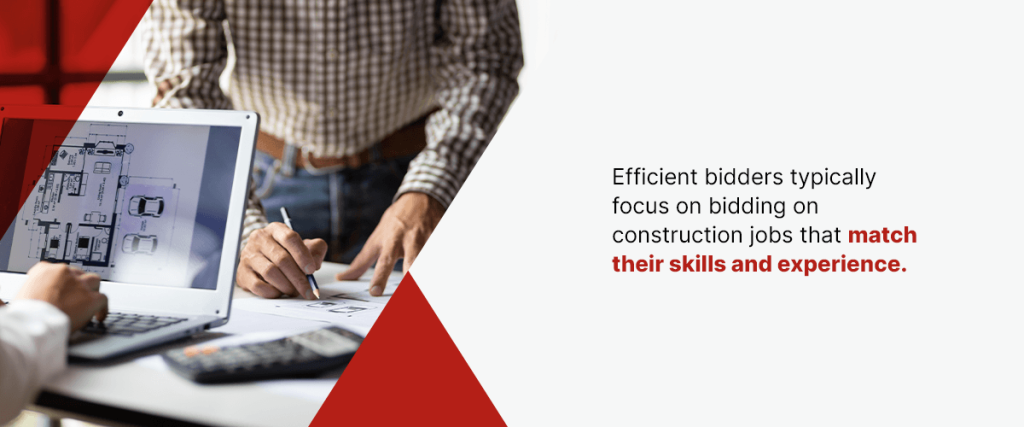
The bidding process sounds simple at first glance. A client sends a request for proposal, the contractor submits a bid and the client chooses a winning contractor to perform the work. However, those steps require many other tasks, like meetings, site visits and detailed calculations. Winning a bid also depends on various factors that can range widely between projects.
Understanding the construction bidding process is crucial for contractors and owners to have realistic expectations and fruitful relationships.
What Is a Construction Bid?
A construction bid describes a contractor’s capabilities and anticipated expenses in response to a client’s RFP. The RFP contains information about the project, such as specifications and the type of contract. Clients may also issue this information through an invitation for bid or request for quote.
Construction job bids are similar to estimates but with much more detail and other elements, such as:
- Scope of work details about materials, services delivered, etc.
- Existing site conditions
- Estimated costs
- Estimated timelines, including payment schedules
- Warranty information
- Bonding, licensing and insurance information
The bid process differs between design-bid-build and design-build projects. If a project uses the more traditional DBB approach, the construction bid occurs after the client has designs in hand, which a separate contractor created. In a DB project, the bid occurs before design, with one contractor performing team selection, pre-construction activities, design and construction.
Stages of a Construction Bid
Construction bids go through several phases before any work can begin. Knowing how to bid on construction jobs involves managing the following stages.
1. Solicitation
The client starts by issuing their RFP, RFQ or IFB. They may send these requests directly to contractors or post them online.
2. Meetings
The client and potential contractors have a phone call, video chat or in-person meeting to discuss project details and ensure everyone is on the same page. Some topics to review include the timeline, budget and scope. The client might hold a pre-bid conference to discuss larger public projects in more detail with interested bidders, clarifying any complex specifications or requirements.
The initial meeting stage is an ideal time for contractors to evaluate whether the job is a good fit. If the contractor and client have significantly different approaches or the contractor doesn’t feel well-equipped to meet the project demands, they can step away without investing more time into the proposal.
3. Site Visit
The contractor then visits the job site to evaluate it and ensure it aligns with the scope outlined in the RFP. They may also start to gauge transportation needs, material staging and potential hazards.
4. Calculation
With all the information collected, the contractor finds qualified subcontractors, crunches the numbers and creates a detailed estimate of project costs, including expenses such as materials and labor. Profit margins and market conditions also affect these prices. Contractors typically use construction management software such as Procore or Bluebeam to create highly accurate estimates and build a polished proposal.
Contractors will consider the contract type when calculating costs. Two options can affect pricing structures.
- Stipulated sum or fixed-price contracts: In these contracts, the client pays the cost specified in the estimate, and the contractor takes on the risks of exceeding their estimate. If costs go beyond the estimate, the client doesn’t pay those additional expenses. The contractor turns more profit if they complete the project under budget.
- Cost-plus contracts: Cost-plus contracts place the responsibility for costs that exceed the estimate on the client. They pay for expenses even if they are higher than anticipated. The contractor’s compensation is a percentage of the actual cost or a fixed sum. These contracts can also have a maximum price, which limits the client’s potential cost.
After finishing calculations, the contractor submits the bid by the deadline according to the RFP’s requirements.
5. Selection and Contract Signing
When the deadline is up, the client evaluates all proposals and chooses the winner based on factors like cost and contractor qualifications. They will then meet with the contractor to review the details, create a contract and sign it.
The only remaining steps are to break ground and start building!
What Makes a Winning Bid?
Every client is different, and identifying what one wants is part of the challenge of winning a bid. Many clients prioritize builders who can achieve the lowest cost, while others look for contractors with impressive qualifications. An informative RFP and a productive meeting can help contractors create the most relevant bid for a client’s needs.
Here are some elements you’ll often find in winning bids.
A Qualified and Well-Matched Contractor
Contractors who submit bids for every project they see risk winning something they’re unqualified for. Of course, a poor fit can create a negative experience for the client, but the contractor could also damage their reputation and increase costs.
Instead, efficient bidders typically focus on bidding on construction jobs that match their skills and experience. This approach can also help contractors avoid wasting time on unwinnable bids.

A Detailed, Accurate Proposal
If a bid doesn’t meet the requirements outlined in an RFP, it could point to a contractor that overlooks other details. Contractors can make effective bids by following the RFP closely and asking questions where necessary.
Accurate estimates minimize risk for the project, especially for fixed-price or maximum-price contracts. Correct calculations help clients make more informed selections and can affect the contractor’s reputation.
Skilled Subcontractors and Tools
Many aspects of the project depend on high-quality partners and resources. Contractors can often strengthen their bids by selecting effective subcontractors for the job and demonstrating valuable tools they use, such as sophisticated construction software.
Organized and Professional Documentation
The documents submitted for the proposal should be clean, polished and organized. The contractor’s business information must be easy to find, and the document ideally contains branding elements, like the company’s logo and colors.
Qualifications and Certifications
Contractors can strengthen their bids by including relevant awards, certifications or specializations. Many clients also want information on the contractor’s bonds, licenses and insurance.
A Solid Reputation
Many clients choose contractors with glowing reputations to minimize risk. Reviews from previous satisfied clients and a robust online presence, such as business profiles on review sites, can communicate trustworthiness and give potential clients peace of mind.
Working With Alta Construction
Construction job bids vary significantly from project to project, and understanding the process is the first step for contractors and clients. At Alta Construction, we strive to deliver an excellent and technology-forward experience that starts with a well-crafted bid. We offer a wide range of construction services, from general contracting and design-build to subcontractor selection and pre-construction budgeting.
If you’re a contractor, request a spot on our bid list for consideration in future projects. If you’re an owner, reach out to us to learn more about our services and see how we can help.


